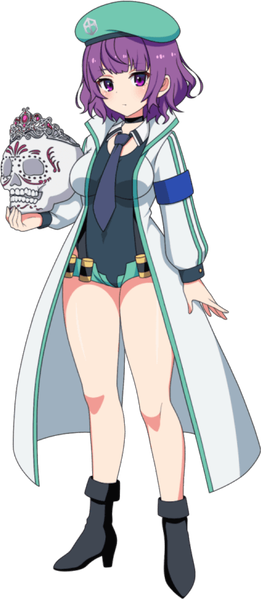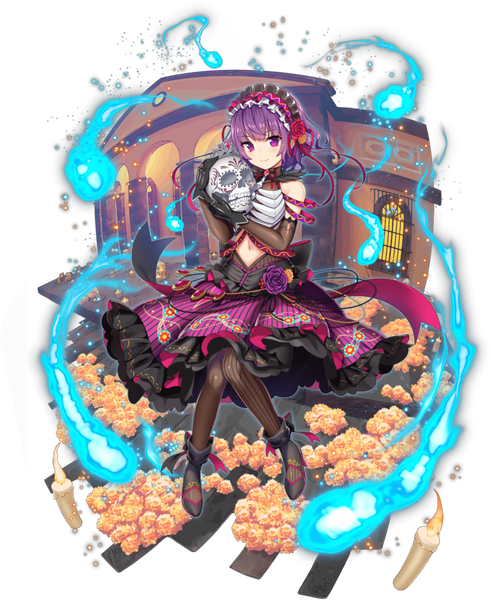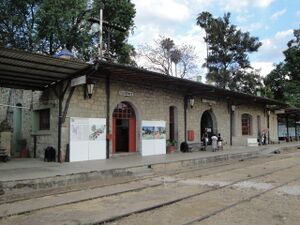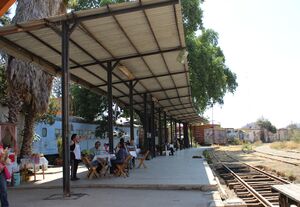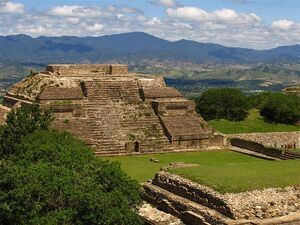Oaxaca
| Oaxaca | |||||
|---|---|---|---|---|---|
| Japanese Name | オアハカ | ||||
| Weapon | |||||
| Race | Human | ||||
| Nationality | |||||
| Birthday | November 13 | ||||
| Constellation | Scorpio | ||||
| Talents | Communicating with the spirit world (but not with her relatives) | ||||
| Likes | Skulls | ||||
| Dislikes | Silent time, Open space | ||||
| Strengths | Listening to people (whether alive or dead) | ||||
| Weaknesses | Dodges inconvenient topics by pretend-speaking to her mother | ||||
| Hobbies | Making skulls | ||||
Hello. I'm Oaxaca from M. Flamarine. I can interact with the spirits of the deceased. But the only spirits I can't talk with are my family. It's strange, isn't it?
Layers
| Icon | Title | Release Date | Where to Obtain |
|---|---|---|---|
| [Whisperer for the Dead] Oaxaca | 2022 July 8 | [Training Camp - Oaxaca] Event Reward | |
| [Phantom Princess] Oaxaca | 2022 July 1 | [Necro Princess in the Underground Crypt] Event Reward | |
| [Investigate Strange Souls] Oaxaca | 2022 June 30 | [Necro Princess in the Underground Crypt] Pick Up Gacha, Premium Gacha |
Skills
Trivia
- Oaxaca's birthday is the opening date of Ferrocarril Mexicano del Sur in 1892.
- Oaxaca's backstory and design is based on Día de Muertos (The Day of the Dead), a holiday traditionally celebrated on November 1 and 2, though other days, such as October 31 or November 6, may be included depending on the locality. The holiday largely originated in Mexico.
- Decorative sugar skulls, called Calaveras, have become one of the most recognizable symbols of Dia de los Muertos.
- Oaxaca is also themed after the ancient landmarks such as the Monte Alban and Mitla ruins, as well as the Catedral Metropolitana de Nuestra Señora de la Asunción and Hierve el Agua.
- Oaxaca's skull may also be a reference to coat of arms of Oaxaca de Juárez - featuring the image of Donají, a Zapotec woman hostage killed and beheaded by the Mixtec in conflict immediately after the Conquest.
- The building in the background of [Investigate Strange Souls] is the Museo Nacional de los Ferrocarriles Mexicanos (National Museum of Mexican Railroads), formerly Estación del Ferrocarril Mexicano (Mexican Railroad station).
Counterpart
Ferrocarril Mexicano del Sur was a train station complex located in the center of Ciudad, Oaxaca de Juárez, built at the end of the 19th century. The old railway station was the work of the Read & Campbell company and was located in the Santa María del Marquesado neighborhood of the Oaxacan capital. The station was inaugurated by General Porfirio Díaz Mori, the President of the Republic on November 13th, 1892, ultimately being the last time that Díaz would visit his home state. Ferrocarril Mexicano del Sur started commercial operations in 1893, serving the train line between the cities of Puebla and Oaxaca.
The station was remodeled in the middle of the 20th century. By the beginning of the 21st century, the station had lost its splendor and original style, so it was remodeled with public funds from the Fondo Nacional para la Cultura y las Artes (National Fund for Culture and the Arts) and the collaboration of the Fundación Alfredo Harp Helú Oaxaca (Alfredo Harp Helú Oaxaca Foundation). The restoration managed to rescue the original architecture of the enclosure.
Due to its contribution of being a part of the Mexican industrial heritage, the buidling is catalogued by the INAH (National Institute of Anthropology and History) of Mexico. With the firm objective of preserving the Railroad Cultural Heritage and disseminating information concerning it for future generations, the Municipality of the City of Oaxaca de Juárez, on the 27th of July of 2001, signed a contract of "comodato" (loan for usage) with the Liquidation Committee of the National Railways of Mexico, for the specific object of creating a thematic museum in the installations of the Old Railroad Station of Oaxaca. This contract was fulfilled with the inauguration of the Museum of the Mexican Railroad of the South in October 12th, 2003.
The inauguration of the new building was on March 3, 2017. The cultural complex houses the Southern Mexican Railway Museum, the Children's Museum of Oaxaca and the BS Railway Library. All their activities are free. The museum displays sepia colored photographs of workers constructing the railroad and picturesque photographs of bridges in black and white. There are also old clocks, gauges, tools, telegraphs, telephones, lanterns, and posters. The creation of this museum was originally considered to be a conservation of the heritage of the old Mexican railway, and as a cultural center. However, the museum is currently considered defunct. The large play area for children still exists, and there is a very active program for students from local schools, but the museum of rail cars were all closed and the external signs had completely disintegrated. Wikipedia
Monte Albán is a large pre-Columbian archaeological site in the Santa Cruz Xoxocotlán Municipality in the southern Mexican state of Oaxaca (17.043° N, 96.767°W). The site is located on a low mountainous range rising above the plain in the central section of the Valley of Oaxaca, where the latter's northern Etla, eastern Tlacolula, and southern Zimatlán and Ocotlán (or Valle Grande) branches meet. The present-day state capital Oaxaca City is located approximately 9 km (6 mi) east of Monte Albán.
The partially excavated civic ceremonial center of the Monte Albán site is situated atop an artificially leveled ridge. It has an elevation of about 1,940 m (6,400 ft) above mean sea level and rises some 400 m (1,300 ft) from the valley floor, in an easily defensible location. In addition to the monumental core, the site is characterized by several hundred artificial terraces, and a dozen clusters of mounded architecture covering the entire ridgeline and surrounding flanks. The archaeological ruins on the nearby Atzompa and El Gallo hills to the north are traditionally considered to be an integral part of the ancient city as well.
Besides being one of the earliest cities of Mesoamerica, Monte Albán was important for nearly one thousand years as the pre-eminent Zapotec socio-political and economic center. Founded toward the end of the Middle Formative period at around 500 BC, by the Terminal Formative (c. 100 BC – AD 200) Monte Albán had become the capital of a large-scale expansionist polity that dominated much of the Oaxacan highlands and interacted with other Mesoamerican regional states, such as Teotihuacan to the north (Paddock 1983; Marcus 1983). The city lost its political pre-eminence by the end of the Late Classic (c. AD 500–750), and soon thereafter was largely abandoned. Small-scale reoccupation, opportunistic reuse of earlier structures and tombs, and ritual visitations marked the archaeological history of the site into the Colonial period. Wikipedia
Map
Gallery
- Pages using Tabber parser tag
- Pages using DynamicPageList3 parser tag
- Weapon Artifact
- Human
- Flamarine
- Scorpio
- Element Cut
- Element Dark
- Metro Train Knights
- Mexico

